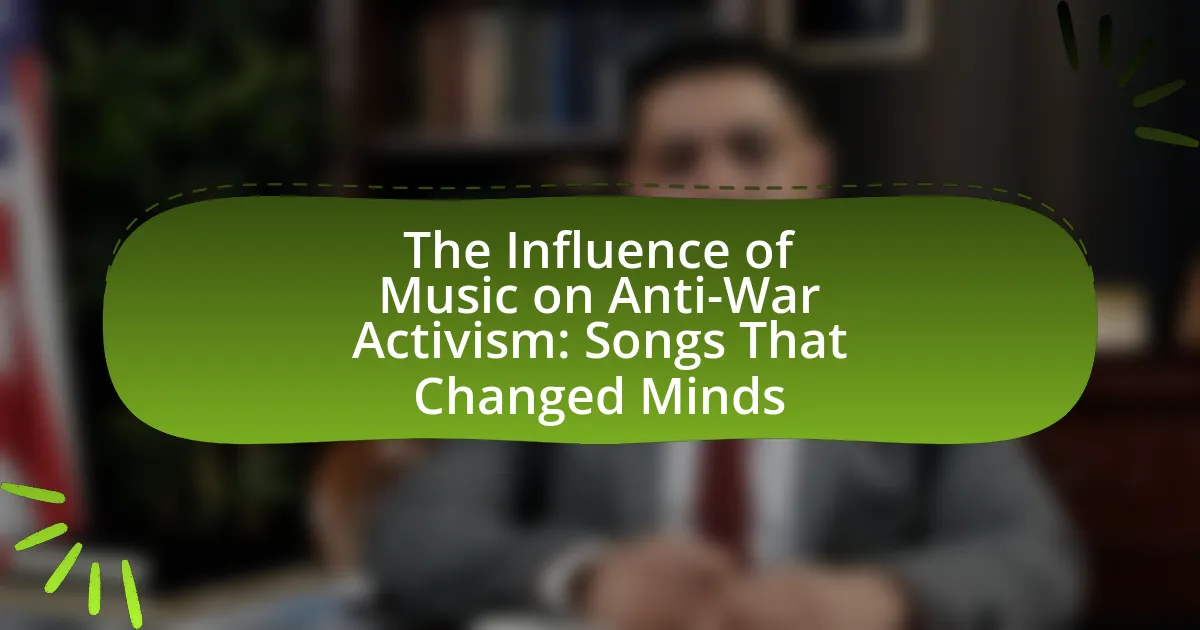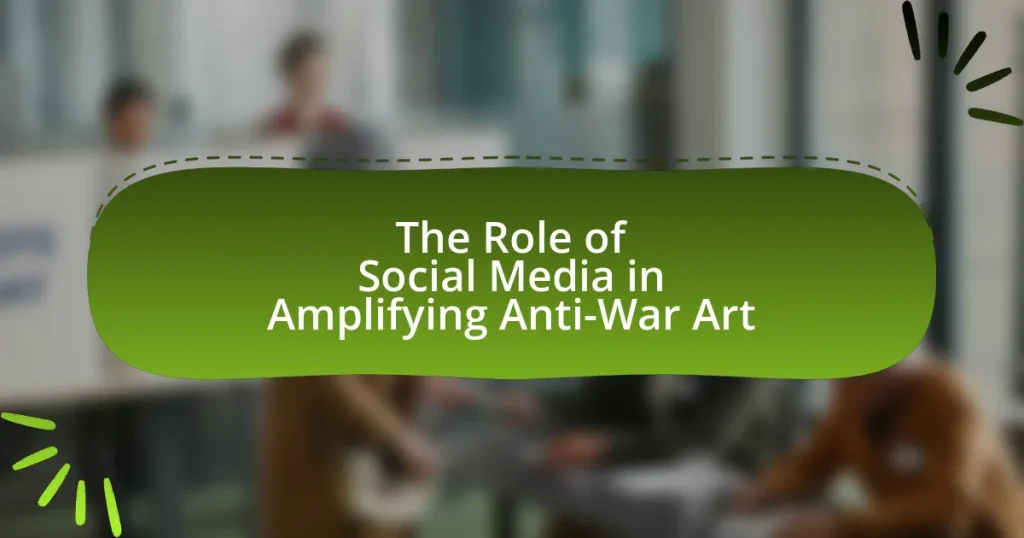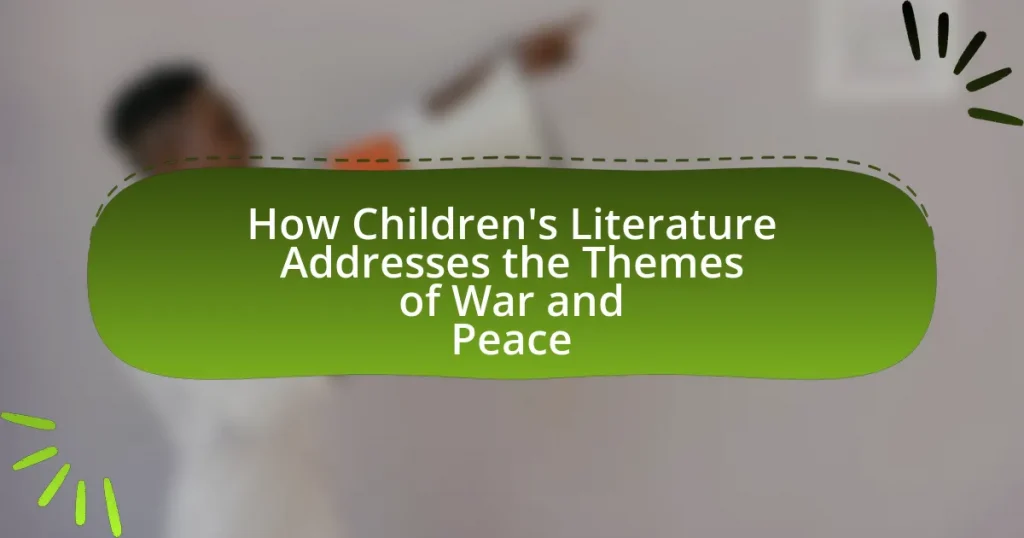The article examines the significant influence of music on anti-war activism, highlighting how songs have historically served as powerful tools for expression, mobilization, and emotional resonance. It discusses key examples, such as “Fortunate Son” by Creedence Clearwater Revival and “Give Peace a Chance” by John Lennon, which galvanized public sentiment against wars, particularly during the Vietnam War era. The article also explores the psychological effects of music on listeners, its role in fostering community among activists, and the lasting impact of protest songs on contemporary anti-war movements. Additionally, it addresses how modern artists continue this tradition and the ways social media amplifies the reach of anti-war music today.
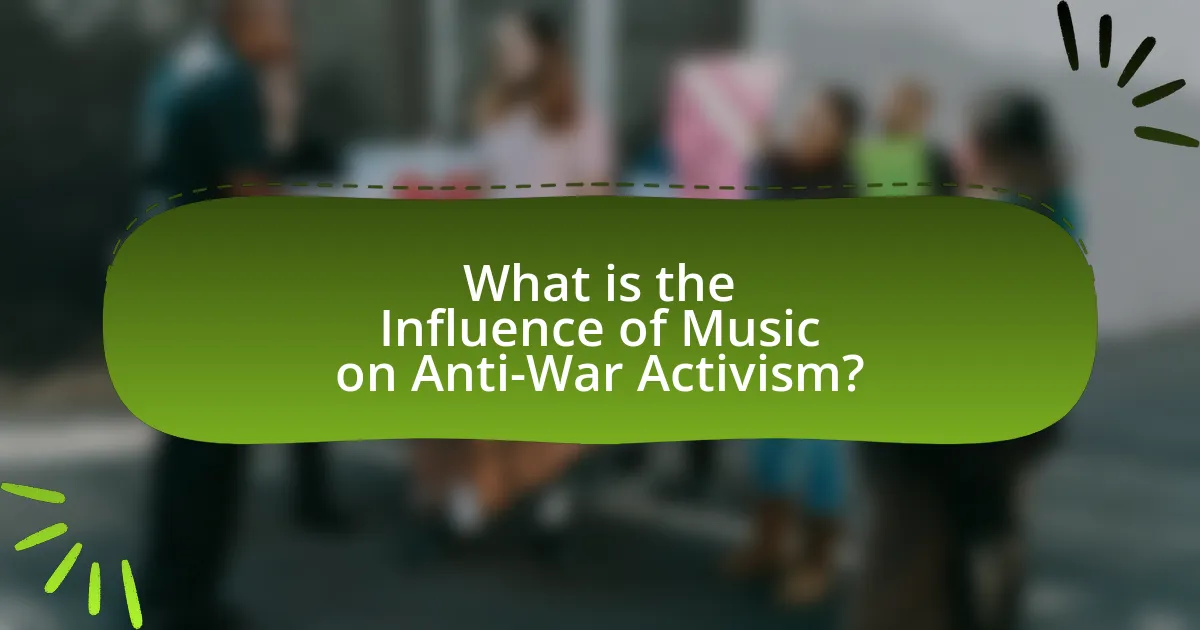
What is the Influence of Music on Anti-War Activism?
Music significantly influences anti-war activism by serving as a powerful tool for expression, mobilization, and emotional resonance. Throughout history, songs like “Fortunate Son” by Creedence Clearwater Revival and “Give Peace a Chance” by John Lennon have galvanized public sentiment against wars, particularly during the Vietnam War era. These songs not only articulated the frustrations and hopes of the anti-war movement but also provided a sense of unity among activists. Research indicates that music can enhance collective identity and motivate individuals to participate in social movements, as evidenced by the widespread use of protest songs in rallies and demonstrations. The emotional impact of music fosters a deeper connection to the cause, making it an essential element in shaping public opinion and driving anti-war efforts.
How has music historically played a role in anti-war movements?
Music has historically played a crucial role in anti-war movements by serving as a powerful medium for expressing dissent and mobilizing public sentiment against conflict. For instance, during the Vietnam War, songs like “Fortunate Son” by Creedence Clearwater Revival and “Give Peace a Chance” by John Lennon became anthems for the anti-war movement, articulating the frustrations of those opposed to the war and galvanizing protests. These songs not only resonated emotionally with listeners but also provided a rallying point for activists, contributing to a broader cultural shift that questioned military engagement. The impact of music in these contexts is evidenced by its ability to reach diverse audiences, foster solidarity among protesters, and influence public opinion, ultimately shaping the discourse around war and peace.
What are some key historical examples of music influencing anti-war sentiments?
Key historical examples of music influencing anti-war sentiments include “Fortunate Son” by Creedence Clearwater Revival during the Vietnam War, which criticized the privilege of those who avoided the draft, and “Give Peace a Chance” by John Lennon, which became an anthem for the anti-war movement. Additionally, “Blowin’ in the Wind” by Bob Dylan posed rhetorical questions about peace and justice, resonating with the civil rights and anti-war movements of the 1960s. These songs galvanized public opinion against the Vietnam War, reflecting widespread discontent and mobilizing protests.
How did specific songs resonate with the public during major conflicts?
Specific songs resonated with the public during major conflicts by encapsulating the emotions, sentiments, and experiences of those affected, often becoming anthems for anti-war movements. For instance, “Fortunate Son” by Creedence Clearwater Revival became a rallying cry against the Vietnam War, expressing frustration over class disparities in military service, which resonated with a generation disillusioned by the conflict. Similarly, Bob Dylan’s “Blowin’ in the Wind” posed poignant questions about peace and justice, capturing the spirit of the civil rights and anti-war movements in the 1960s. These songs not only reflected public sentiment but also mobilized listeners, fostering a sense of unity and purpose among anti-war activists.
Why is music considered a powerful tool for activism?
Music is considered a powerful tool for activism because it has the ability to evoke emotions, unify communities, and convey messages effectively. Historically, songs like “Give Peace a Chance” by John Lennon became anthems for the anti-war movement, illustrating how music can mobilize people and amplify their voices. Research indicates that music can enhance group cohesion and inspire collective action, making it a strategic medium for social change. For instance, a study published in the Journal of Social Issues highlights that music can facilitate emotional engagement, which is crucial for motivating individuals to participate in activism.
What psychological effects does music have on listeners in the context of activism?
Music has significant psychological effects on listeners in the context of activism, primarily by enhancing emotional engagement and fostering a sense of community. Research indicates that music can evoke strong emotions, which can motivate individuals to take action and support social causes. For instance, songs associated with anti-war movements, such as “Fortunate Son” by Creedence Clearwater Revival, have historically galvanized public sentiment against conflict, illustrating how music can shape perceptions and inspire collective action. Additionally, studies show that music can create a shared identity among listeners, reinforcing group solidarity and commitment to activism, as evidenced by the role of protest songs in the civil rights movement.
How does music create a sense of community among activists?
Music creates a sense of community among activists by fostering shared emotional experiences and collective identity. Through songs that resonate with their struggles, activists can unite around common goals and values, enhancing solidarity. Historical examples, such as the anti-war movement of the 1960s, illustrate this phenomenon; songs like “Give Peace a Chance” by John Lennon became anthems that galvanized large groups, creating a collective voice and reinforcing a sense of belonging among participants. This shared musical experience not only strengthens interpersonal connections but also amplifies the movement’s message, making it more impactful and cohesive.
![]()
What are some iconic anti-war songs that changed minds?
Some iconic anti-war songs that changed minds include “Fortunate Son” by Creedence Clearwater Revival, “Give Peace a Chance” by John Lennon, and “War” by Edwin Starr. “Fortunate Son,” released in 1969, critiques the privilege of those who evade the draft, resonating with the disillusionment of the Vietnam War era. “Give Peace a Chance,” also from 1969, became an anthem for the peace movement, emphasizing the call for non-violence. “War,” released in 1970, directly questions the morality of conflict, famously stating, “War, huh, yeah, what is it good for? Absolutely nothing.” These songs played significant roles in shaping public opinion against war during their respective periods.
Which songs are most recognized for their anti-war messages?
“Fortunate Son” by Creedence Clearwater Revival, “Imagine” by John Lennon, and “Give Peace a Chance” also by John Lennon are among the most recognized songs for their anti-war messages. “Fortunate Son,” released in 1969, critiques the privilege of those who evade the draft, highlighting class disparities during the Vietnam War. “Imagine,” released in 1971, envisions a world without war and conflict, promoting peace and unity. “Give Peace a Chance,” released in 1969, became an anthem for the anti-war movement, encouraging collective action against war. These songs have left a lasting impact on public consciousness regarding war and peace.
What themes are prevalent in these iconic anti-war songs?
Prevalent themes in iconic anti-war songs include the futility of war, the human cost of conflict, and calls for peace. These songs often highlight the emotional and physical toll on soldiers and civilians, emphasizing the senselessness of violence. For instance, “Fortunate Son” by Creedence Clearwater Revival critiques social inequality and the disparity in who bears the burden of war, while “Imagine” by John Lennon envisions a world without conflict. Such themes resonate deeply, reflecting societal disillusionment and advocating for peace, which has historically galvanized public sentiment against war.
How did the artists’ backgrounds influence their anti-war messages?
Artists’ backgrounds significantly influenced their anti-war messages by shaping their perspectives and motivations. For instance, many artists who experienced war firsthand, such as veterans or those from war-torn regions, conveyed deep emotional responses and personal narratives in their music, which resonated with audiences. Bob Dylan, who grew up during the Cold War, infused his songs with a sense of urgency and disillusionment, reflecting the societal tensions of the time. Similarly, artists like Joan Baez, who were involved in civil rights movements, used their platforms to advocate for peace, drawing from their experiences of social injustice. These backgrounds provided authenticity and urgency to their messages, making their anti-war sentiments more impactful and relatable to listeners.
How did specific songs impact public opinion during wars?
Specific songs significantly shaped public opinion during wars by conveying powerful anti-war messages and mobilizing social movements. For instance, “Fortunate Son” by Creedence Clearwater Revival became an anthem for the anti-Vietnam War movement, criticizing the disparity between those who were drafted and the privileged elite who avoided service. This song resonated with the youth and fueled protests, reflecting widespread discontent with U.S. involvement in Vietnam. Similarly, “Give Peace a Chance” by John Lennon galvanized peace activists, becoming a rallying cry for demonstrations and emphasizing the desire for non-violent resolutions. These songs not only influenced individual attitudes but also contributed to a broader cultural shift against war, as evidenced by increased public protests and changing perceptions of military engagement during the 1960s and 1970s.
What role did radio and television play in promoting these songs?
Radio and television played a crucial role in promoting anti-war songs by providing widespread access to these messages, significantly amplifying their reach. During the Vietnam War era, radio stations frequently aired protest songs, such as “Fortunate Son” by Creedence Clearwater Revival, which resonated with the growing anti-war sentiment. Television programs, including news broadcasts and music shows, featured performances of these songs, further embedding them in the cultural consciousness. For instance, the televised Woodstock festival in 1969 showcased numerous anti-war artists, effectively bringing their messages to millions of viewers. This combination of audio and visual media not only popularized the songs but also helped to galvanize public opinion against the war, demonstrating the powerful influence of radio and television in shaping social movements.
How did live performances of these songs contribute to their impact?
Live performances of anti-war songs significantly amplified their impact by creating a direct emotional connection between artists and audiences. These performances often took place at pivotal moments in history, such as protests or rallies, where the collective experience of the audience heightened the songs’ messages. For instance, during the Vietnam War, artists like Joan Baez and Bob Dylan performed at large gatherings, which not only drew attention to the anti-war movement but also fostered a sense of solidarity among attendees. The immediacy of live music allowed for spontaneous expressions of dissent, making the songs more resonant and memorable. Additionally, the visual and auditory elements of live performances, such as passionate delivery and audience participation, reinforced the urgency of the anti-war message, leading to increased public awareness and activism.
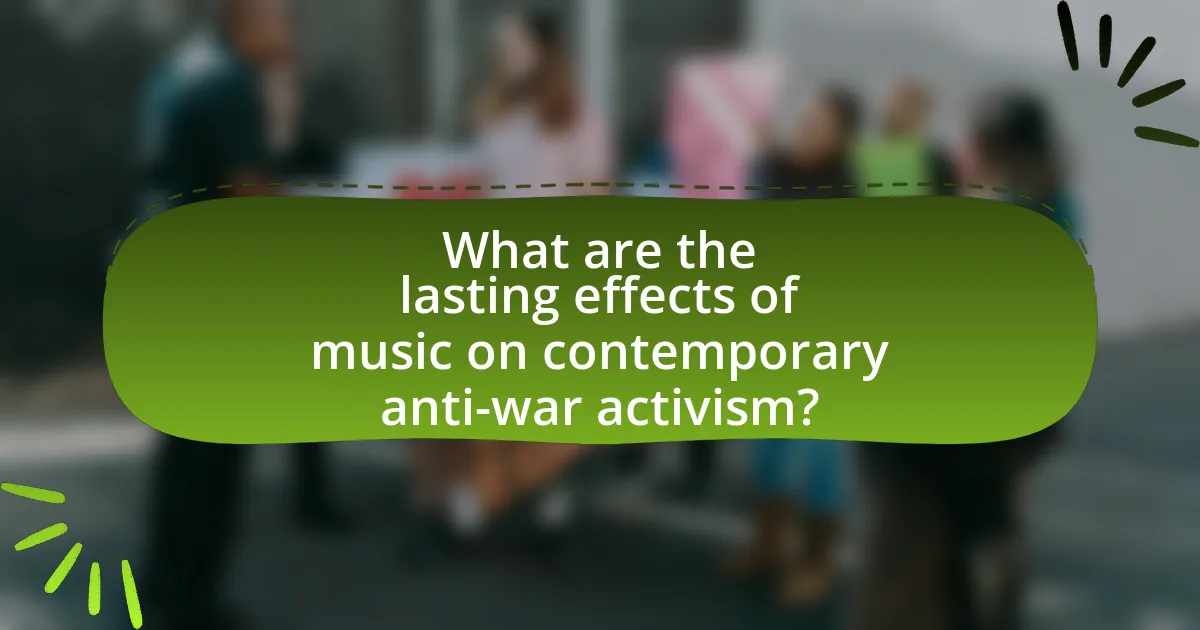
What are the lasting effects of music on contemporary anti-war activism?
Music has a profound and lasting effect on contemporary anti-war activism by serving as a powerful tool for emotional expression and mobilization. Songs like “Fortunate Son” by Creedence Clearwater Revival and “Imagine” by John Lennon have become anthems that resonate with anti-war sentiments, fostering a sense of community and shared purpose among activists. These musical pieces often highlight the human cost of war, influencing public opinion and encouraging political engagement. Research indicates that music can enhance collective identity and solidarity, making it easier for movements to gain traction and sustain momentum. For instance, during the Vietnam War, music played a crucial role in shaping the anti-war narrative, leading to significant public demonstrations and policy changes. Thus, the lasting effects of music on contemporary anti-war activism include its ability to inspire action, unify diverse groups, and articulate dissent against military conflicts.
How do modern artists continue the tradition of using music for activism?
Modern artists continue the tradition of using music for activism by addressing social and political issues through their lyrics and performances. For instance, artists like Billie Eilish and Kendrick Lamar tackle themes such as climate change and racial inequality, respectively, using their platforms to raise awareness and inspire action. Eilish’s song “All the Good Girls Go to Hell” highlights environmental concerns, while Lamar’s “Alright” has become an anthem for the Black Lives Matter movement. These examples illustrate how contemporary musicians leverage their influence to engage audiences in critical conversations, thereby perpetuating the legacy of music as a tool for social change.
What are some recent examples of songs that address current conflicts?
Recent examples of songs that address current conflicts include “This Is America” by Childish Gambino, which critiques gun violence and systemic racism in the United States, and “Praying” by Kesha, which addresses themes of resilience in the face of personal and societal struggles. Additionally, “The Village” by The War on Drugs reflects on the impact of war and displacement. These songs resonate with contemporary issues, highlighting the role of music in raising awareness and fostering dialogue about conflicts.
How do social media platforms amplify the reach of anti-war music today?
Social media platforms amplify the reach of anti-war music today by enabling rapid sharing and engagement among users. These platforms allow artists to distribute their music directly to a global audience without traditional gatekeepers, facilitating viral dissemination. For instance, a song can gain millions of views and shares within hours, as seen with tracks like “Killing in the Name” by Rage Against the Machine, which has been widely circulated on platforms like YouTube and TikTok during times of conflict. Additionally, algorithms on social media prioritize content that generates engagement, further increasing visibility for anti-war messages. This dynamic creates a feedback loop where user interactions can propel songs into mainstream awareness, making anti-war music more accessible and influential in shaping public opinion against war.
What lessons can be learned from the influence of music on anti-war activism?
The influence of music on anti-war activism teaches that songs can effectively mobilize public sentiment and foster solidarity among activists. Historical examples, such as Bob Dylan’s “Blowin’ in the Wind” and Joan Baez’s performances during the Vietnam War, illustrate how music can articulate dissent and inspire collective action. These songs resonated with audiences, amplifying anti-war messages and encouraging participation in protests, demonstrating that music serves as a powerful tool for social change. Additionally, studies show that music can enhance emotional engagement, making political messages more relatable and memorable, thus reinforcing the role of music in shaping public opinion against war.
How can activists effectively use music to promote their causes?
Activists can effectively use music to promote their causes by creating emotionally resonant songs that convey their messages and inspire action. For instance, during the Vietnam War, songs like “Fortunate Son” by Creedence Clearwater Revival became anthems for anti-war sentiment, highlighting social injustices and galvanizing public opinion against the war. Research indicates that music can enhance emotional engagement, making messages more memorable and impactful, as seen in studies by the University of Southern California, which found that music can significantly influence attitudes and behaviors. By leveraging catchy melodies and relatable lyrics, activists can foster a sense of community and urgency, encouraging listeners to participate in movements and advocate for change.
What strategies can be employed to create impactful anti-war songs?
To create impactful anti-war songs, artists should focus on emotional storytelling, relatable lyrics, and strong melodies. Emotional storytelling engages listeners by conveying personal experiences or historical events related to war, making the message resonate on a deeper level. Relatable lyrics that reflect common sentiments about the consequences of war can foster a connection with the audience, encouraging them to reflect on their own beliefs and experiences. Strong melodies enhance memorability, allowing the song to remain in listeners’ minds and spread more effectively. Historical examples, such as Bob Dylan’s “Blowin’ in the Wind,” illustrate how these strategies can effectively communicate anti-war sentiments and inspire activism.
